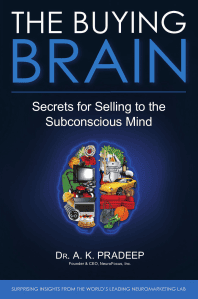 Have you ever seen an ad that made your mouth water? Or better yet, sent you to the kitchen to forage for a snack?
Have you ever seen an ad that made your mouth water? Or better yet, sent you to the kitchen to forage for a snack?
Those ads probably relied on a proven technique for increasing people’s desire. They incorporated sensory writing to tickle your senses.
Any time sales copy engages people on a sensory level, it pulls better.
The more senses it engages, the more persuasive it is.
Why?
Because sensory writing connects with the subconscious mind. According to Dr. A. K. Pradeep, world’s leading neuromarketing researcher, it triggers the “buying brain.”
In his book, not surprisingly titled The Buying Brain, he teaches that you can sell more if you sell to the subconscious (or primitive) brain. Here’s the gist of his message:
“The basic lesson is that human brains process much of their sensory input subconsciously.”
“Our senses are taking in about 11 million bits of information every second.”
“Our thinking brains—that part of thinking in which we are aware of thinking—can only process, at best, 40 bits of information per second.”
“The subconscious level of the brain is where elements that are essential to marketing success such as initial product interest, purchase, intent, and brand loyalty are formed, and where they reside.”
Wow! That’s an important realization for marketers.
By triggering the subconscious, you can spark desire for your product without the person being aware of what you’ve done. You trigger their buying impulse subconsciously, so they never feel manipulated. They simply want.
So how do you do that?
How do you “tickle” the senses to generate subconscious desire? When you write your sales copy, incorporate four simple techniques.
1. Use sensory adjectives
Rough day… bright idea… slippery subject… stone-cold data…
Use words that are associated with touch, sight or even smell, and you’ll end up with copy that’s more compelling and memorable.
This is an easy way to add sensory details to your copy—except for one thing. You need to be careful to avoid clichés.
When you’re trying to do this, the first words that come to mind will likely be the phrases and metaphors you’ve grown up hearing. Things like “sweet as sugar” or “right as rain.” Yes, you can opt to use them anyway, but you won’t get the same results.
You’ll have more luck connecting with people’s subconscious if you create new comparisons: “sweet as a baby’s smile” or “red as the first sunburn of the season.” And lively adjectives: “slimy” spammers, “sour” sales tactics.
You don’t have to be overly creative. Just come up with something new:
“It’s one of the most powerful, easy-to-follow, “hold your hand” systems in the world for rapidly developing a profitable online business.” (Brian Edmondson’s Internet Money Club promo)
2. Ramp up your verbs
The real power in your copy comes from the verbs. So don’t let them sit there doing nothing. Activate them. And whenever possible, make them sensory.
How can verbs be sensory? Good question.
Look for verbs that evoke a feeling: tickle, languish, sizzle, stew…
If the word is associated with primal activities—eating or pleasure, for example—you’ll generate a similar physical response simply by using those words.
This is especially true for scent. Pradeep says, “Once a scent is embedded in an individual’s brain, even visual cues can cause it to be resurrected and even ‘experienced.’”
Don’t overdo it, of course. But do sprinkle evocative verbs throughout your copy to connect with people on a deeper level.
For example:
“The blog is spiced up with family-friendly content, such as a how-to post on making a bunny cake.” (by Emma Siemasko, originally on Crazy Egg)
3. Use images of people enjoying the product
This holiday season, millions of children will watch wide-eyed, as commercials show other children gleefully playing with one toy or another. As soon as the commercial ends, they’ll turn to a parent and announce, “I want that!”
They don’t necessarily want the toy. They want the happiness those other children are experiencing in the commercial. Surely if they have the same toy, they’ll feel the same joy.
Ironically, it’s a response we never fully outgrow. We always want what other people have.
So don’t just describe your product. Describe how others are using it… how it’s helping them solves their problems… how happy it makes them.
People will want those same results and, by extension, your product.
You can do that with words like International Living does it here:
“In February of 1985 we published an article explaining how to fly around the world for less than $1,000. At the time, that wasn’t even half the regular fare.
In fact, it was so low that some subscribers didn’t believe it was possible. One actually put us to the test. David Hendrickson and his wife followed our instructions and actually flew around the world—with stopovers in London, New York, Bangkok, Hong Kong, and Tokyo, for less than $1,000!”
But whenever possible, use images. Not canned images. Real people using your product.
4. Use unique language that stands out from the competition
The brain craves novelty. According to Pradeep, we’re hard-wired to notice (and respond to) anything that’s different.
That’s one of the reasons you need to figure out what’s unique about your product and differentiate it from the competition.
But you also want your sales copy to stand out. Think about it: If you use the same tired descriptions everyone else uses, people’s eyes will glaze over when they read your stuff.
Don’t do that. Energize your copy. Create something new. I love it when I’m reading something and come across lively descriptions. They all but jump off the page:
“This rosy blush blend of pu-erh black and green oolong teas merge to create an intoxicating mix of sweet fruit with bright mint. Sweet strawberries and golden delicious apples swirl into peppermint and spearmint and create guilt-free, slimful beauty inside and out.” (Teavana)
“Tough luxe. Motorcycle details mix with soft ruffles cascading down the front of an incredibly supple leather jacket. A pearlized neutral gives it luster…” (White House Black Market)
The words activate my senses. My imagination does the rest.
Try to do the same with your own sales copy.
Remember, as Eurgene Schwartz once said, we don’t sell products; we sell desire. Making people want something is a lot easier once you’ve activated their senses, especially when you’re selling online.
When selling online, you have to make your product seem real, show others enjoying it, and help people see themselves using it—especially since they can’t touch it, try it on or examine the box.
So don’t stop at describing the benefits. Make your product three-dimensional. Make it sensory, and you’ll sell to the subconscious—which is where the sale actually happens.
Thoughts? Ideas? What do you do to make your digital marketing more sensory?



